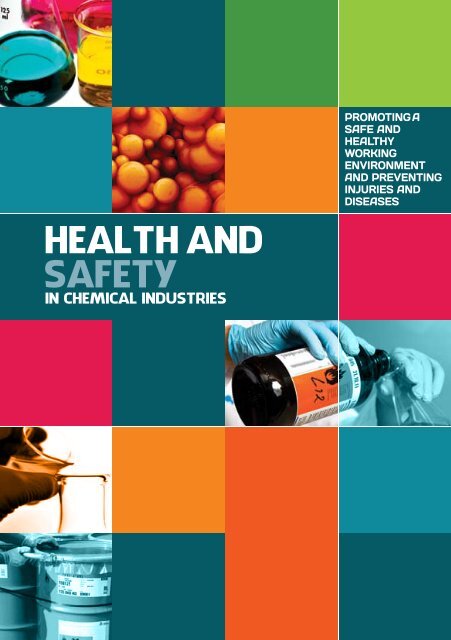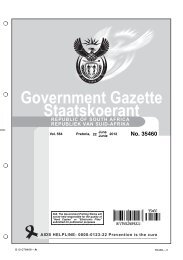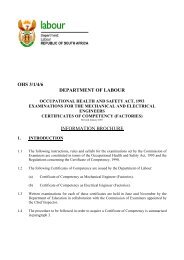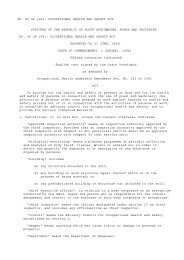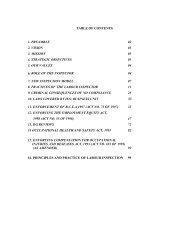Health and Safety in Chemical Industries.pdf - Department of Labour
Health and Safety in Chemical Industries.pdf - Department of Labour
Health and Safety in Chemical Industries.pdf - Department of Labour
You also want an ePaper? Increase the reach of your titles
YUMPU automatically turns print PDFs into web optimized ePapers that Google loves.
HEALTH AND<br />
SAFETY<br />
IN CHEMICAL INDUSTRIES<br />
PROMOTING A<br />
SAFE AND<br />
HEALTHY<br />
WORKING<br />
ENVIRONMENT<br />
AND PREVENTING<br />
INJURIES AND<br />
DISEASES
<strong>Chemical</strong>s <strong>in</strong>clude household item such<br />
as dish-wash<strong>in</strong>g soap <strong>and</strong> floor cleaners<br />
Introduction<br />
Every year many workers are <strong>in</strong>jured, become ill or are killed because <strong>of</strong> exposure to harmful chemical<br />
substances. These <strong>in</strong>cidents cause human suffer<strong>in</strong>g, loss <strong>of</strong> production <strong>and</strong> high medical cost. This pamphlet<br />
aims to give assistance <strong>and</strong> guidance to employers <strong>and</strong> workers to promote a safe <strong>and</strong> healthy work<br />
environment <strong>and</strong> prevent <strong>in</strong>juries.<br />
Occupational <strong>Health</strong> <strong>and</strong> <strong>Safety</strong><br />
Occupational health <strong>and</strong> safety is about prevent<strong>in</strong>g people from be<strong>in</strong>g harmed by work or becom<strong>in</strong>g ill from<br />
work by tak<strong>in</strong>g adequate precautions <strong>and</strong> provid<strong>in</strong>g a safe <strong>and</strong> healthy work environment.<br />
Hazardous <strong>Chemical</strong> Substances (HCS)<br />
Accord<strong>in</strong>g to the Regulations for Hazardous <strong>Chemical</strong> Substances (1995), HCS means any toxic, harmful,<br />
corrosive, irritant or asphyxiant substance or a mixture <strong>of</strong> such substances for which:<br />
a) an occupational exposure limit is prescribed<br />
b) an occupational exposure limit is not prescribed, but which creates a hazard to health.<br />
<strong>Health</strong> <strong>and</strong> <strong>Safety</strong> Risks <strong>in</strong> <strong>Chemical</strong> <strong>Industries</strong><br />
Work<strong>in</strong>g with chemicals <strong>and</strong>/or <strong>in</strong> a chemical <strong>in</strong>dustry poses many risks, <strong>in</strong>clud<strong>in</strong>g caus<strong>in</strong>g the follow<strong>in</strong>g<br />
diseases/<strong>in</strong>juries:<br />
<strong>Chemical</strong> burns<br />
Asthma<br />
Allergies<br />
Irritant contact dermatitis<br />
Allergic contact dermatitis<br />
Sk<strong>in</strong> <strong>in</strong>fections<br />
Sk<strong>in</strong> <strong>in</strong>juries<br />
Sk<strong>in</strong> cancers<br />
Other cancers<br />
Asphyxiation<br />
Reproductive problems<br />
Death.<br />
2 <strong>Health</strong> <strong>and</strong> <strong>Safety</strong> <strong>in</strong> the <strong>Chemical</strong> Industry
All hazards associated with chemicals should be identified.<br />
Risk assessment <strong>of</strong> chemicals<br />
A risk assessment is simply a careful exam<strong>in</strong>ation <strong>of</strong> what, at work, could cause harm to workers. Accidents<br />
<strong>and</strong> ill health can ru<strong>in</strong> lives <strong>and</strong> affect bus<strong>in</strong>ess if output is lost; mach<strong>in</strong>ery is damaged, <strong>in</strong>surance costs<br />
<strong>in</strong>crease. All risks <strong>in</strong> the workplace must be identified <strong>and</strong> assessed for control measures to be put <strong>in</strong> place.<br />
Follow the five steps <strong>of</strong> hazard identification, risk assessment:<br />
• Identify the hazards<br />
• Decide who might be harmed <strong>and</strong> how<br />
• Evaluate the risks <strong>and</strong> decide on precaution<br />
• Record your f<strong>in</strong>d<strong>in</strong>gs <strong>and</strong> implement them<br />
• Review your assessment <strong>and</strong> update if necessary.<br />
Note:<br />
• A hazard is anyth<strong>in</strong>g that may cause harm, such as chemicals, electricity, work<strong>in</strong>g from ladders,<br />
an open drawer<br />
• The risk is the chance, high or low, that somebody could be harmed by these <strong>and</strong> other hazards,<br />
together with an <strong>in</strong>dication <strong>of</strong> how serious the harm could be.<br />
Exposure<br />
Time<br />
Breath<strong>in</strong>g<br />
Rate<br />
Concentration<br />
Toxicity<br />
Individual<br />
Sensitivity<br />
Occupational Exposure Limit<br />
Workers exposed to chemicals at work may NOT be exposed to levels <strong>of</strong> chemicals exceed<strong>in</strong>g the<br />
occupational exposure limit (OEL).<br />
“OEL” or “occupational exposure limit” means a limit value set by the M<strong>in</strong>ister for a stress factor <strong>in</strong> the<br />
workplace as revised from time to time by notice <strong>in</strong> the Government Gazette.<br />
<strong>Health</strong> <strong>and</strong> <strong>Safety</strong> <strong>in</strong> the <strong>Chemical</strong> Industry 3
Limit the number <strong>of</strong> workers <strong>and</strong> time exposed to chemicals<br />
Commonly occurr<strong>in</strong>g hazardous chemicals<br />
Acetone<br />
Ammonia<br />
Ars<strong>in</strong>e<br />
Benzene<br />
Benzoyl peroxide<br />
Beryllium<br />
Chlor<strong>in</strong>e<br />
Chlor<strong>of</strong>orm<br />
Chromium<br />
Cyclohexene<br />
Diethylene glycol<br />
Dimethyl sulphate<br />
Ethanol<br />
Ethyl chloride<br />
Fluor<strong>in</strong>e<br />
Formic acid<br />
Glycerol mist<br />
Glutaraldehyde<br />
Heptachor<br />
Hexylene glycol<br />
Hydrogen chloride<br />
Iod<strong>in</strong>e<br />
Iron oxide<br />
Isophorone<br />
Ketene<br />
Liquified petroleum gas<br />
Lithium Hydroxide<br />
Manganese tetroxide<br />
Methanol<br />
Methylal<br />
Nicot<strong>in</strong>e<br />
Nitric acid<br />
Nitromethane<br />
Oxalonitrile<br />
Ozone<br />
Phenol<br />
Phenylethylene<br />
Picric acid<br />
Piperid<strong>in</strong>e<br />
Qu<strong>in</strong>one<br />
Resorc<strong>in</strong>ol<br />
Selenium<br />
Silica dust<br />
Sodium fluoroacetate<br />
Strychn<strong>in</strong>e<br />
Sulphur monochloride<br />
Tetrabromomethane<br />
Tetramethyl pyrophosphate<br />
Tetryl<br />
Tolene<br />
Vunyl acetate<br />
Xylene<br />
Yttrium<br />
Zirconium compounds<br />
Exposure to chemicals<br />
Us<strong>in</strong>g chemicals or other hazardous substances at work can put people’s health at risk, caus<strong>in</strong>g diseases<br />
<strong>in</strong>clud<strong>in</strong>g asthma, dermatitis or cancer.<br />
A worker’s sk<strong>in</strong> may be exposed to hazardous chemicals through:<br />
• direct contact with contam<strong>in</strong>ated surfaces<br />
• deposition <strong>of</strong> aerosols<br />
• immersion<br />
• splashes.<br />
4 <strong>Health</strong> <strong>and</strong> <strong>Safety</strong> <strong>in</strong> the <strong>Chemical</strong> Industry
Sk<strong>in</strong> should be protected<br />
aga<strong>in</strong>st exposure to chemicals<br />
<strong>Chemical</strong> burns susta<strong>in</strong>ed<br />
from sulphuric acid spilled<br />
from car battery<br />
Contact dermatitis caused by chemicals<br />
Contact dermatitis is <strong>in</strong>flammation <strong>of</strong> the sk<strong>in</strong> caused by contact with a wide range <strong>of</strong> materials, most<br />
commonly contact dermatitis <strong>in</strong> the workplace is caused by chemicals. The most commonly affected area on<br />
the body is the h<strong>and</strong>s.<br />
The severity <strong>of</strong> contact dermatitis depends on many factors:<br />
• Characteristics <strong>of</strong> the hazardous agent<br />
• Concentration <strong>of</strong> the hazardous agent<br />
• Duration <strong>and</strong> frequency <strong>of</strong> exposure to the hazardous agent<br />
• Environmental factors (temperature, humidity)<br />
• Condition <strong>of</strong> the sk<strong>in</strong> (damaged sk<strong>in</strong>, dry or wet).<br />
Avoid<strong>in</strong>g contact with chemicals will prevent contact dermatitis. Avoid contact<br />
through the follow<strong>in</strong>g methods:<br />
• Substitute a hazardous material with a safer alternative<br />
• Automate the process<br />
• Enclose the process<br />
• H<strong>and</strong>le materials mechanically<br />
• Don’t h<strong>and</strong>le materials directly with h<strong>and</strong>s<br />
• Observe a safe work distance.<br />
If contact cannot be avoided, the sk<strong>in</strong> will need protection:<br />
• Tra<strong>in</strong> workers on risks <strong>of</strong> chemicals they use <strong>in</strong> the workplace<br />
• Promote good personal hygiene<br />
• Provide wash<strong>in</strong>g facilities, <strong>in</strong>clud<strong>in</strong>g soap <strong>and</strong> dry<strong>in</strong>g facilities<br />
• Provide proper protective equipment (gloves, aprons)<br />
• Tra<strong>in</strong> workers on the correct use <strong>of</strong> protective equipment<br />
• Replace protective equipment when necessary.<br />
Information workers should know regard<strong>in</strong>g hazardous chemicals<br />
An employer shall, ensure that the employee is adequately tra<strong>in</strong>ed with regard to:<br />
• The contents <strong>of</strong> the regulations for hazardous chemical substances<br />
• Potential source exposure to chemicals<br />
• Potential risks to health caused by exposure<br />
• Potential detrimental effect <strong>of</strong> exposure on his/her reproductive ability<br />
• Measures taken by the employer to protect employees aga<strong>in</strong>st any risk from exposure<br />
• Precautions to be taken by an employee to protect himself aga<strong>in</strong>st the health risks<br />
associated exposure<br />
• Correct use, ma<strong>in</strong>tenance <strong>of</strong> safety equipment, facilities <strong>and</strong> eng<strong>in</strong>eer<strong>in</strong>g controls<br />
• Importance <strong>of</strong> good housekeep<strong>in</strong>g at the workplace <strong>and</strong> personal hygiene<br />
• Safe work<strong>in</strong>g procedures<br />
• Procedures to be followed <strong>in</strong> the event <strong>of</strong> spillages or leakages.<br />
<strong>Health</strong> <strong>and</strong> <strong>Safety</strong> <strong>in</strong> the <strong>Chemical</strong> Industry 5
<strong>Chemical</strong>s decanted <strong>in</strong>to unlabeled<br />
conta<strong>in</strong>ers should not be allowed<br />
Label<strong>in</strong>g <strong>of</strong> hazardous chemical substances<br />
Labels on chemicals can help identify more hazardous chemicals, tell about the dangers to health <strong>and</strong><br />
<strong>in</strong>form on safeguard<strong>in</strong>g methods.<br />
All chemical conta<strong>in</strong>ers should be properly identified <strong>and</strong> classified <strong>and</strong> smaller decant<strong>in</strong>g conta<strong>in</strong>ers should<br />
be clearly labeled with regards to the contents <strong>of</strong> the conta<strong>in</strong>er.<br />
Information that should be available on all chemicals used <strong>in</strong> the workplace:<br />
• Product identification<br />
• Company identification<br />
• Composition/<strong>in</strong>formation on <strong>in</strong>gredients<br />
• Hazards identification<br />
• First-aid measures<br />
• Fire-fight<strong>in</strong>g measures<br />
• Accidental release measures<br />
• H<strong>and</strong>l<strong>in</strong>g <strong>and</strong> storage<br />
• Exposure control/personal protection<br />
• Physical <strong>and</strong> chemical properties<br />
• Stability <strong>and</strong> reactivity<br />
• Toxicological <strong>in</strong>formation<br />
• Ecological <strong>in</strong>formation<br />
• Disposal considerations<br />
• Transport <strong>in</strong>formation<br />
• Regulatory <strong>in</strong>formation <strong>and</strong><br />
• Any other relevant <strong>in</strong>formation.<br />
Po<strong>in</strong>ts to remember about types <strong>of</strong> chemicals found <strong>in</strong> the workplace:<br />
• The physical form <strong>of</strong> a chemical can affect how it enters your body <strong>and</strong>, to some extent, the<br />
damage it causes<br />
• The ma<strong>in</strong> physical forms <strong>of</strong> toxic chemicals are: solids, dusts, liquids, vapors <strong>and</strong> gases<br />
• Solids are the least likely <strong>of</strong> the chemical forms to cause chemical <strong>in</strong>juries. However, some<br />
chemicals <strong>in</strong> solid form can give <strong>of</strong>f toxic dusts or vapors which can be <strong>in</strong>haled. Effective control<br />
measures should be used with chemical solids, especially dur<strong>in</strong>g work processes that may change<br />
them <strong>in</strong>to more hazardous forms<br />
• Workers can be exposed to occupational dust from materials that normally exist <strong>in</strong> dust form<br />
or from work processes that create dust. The ma<strong>in</strong> danger from harmful dusts is that it can be<br />
<strong>in</strong>haled. Effective control measures should be used to keep occupational dusts at “safe” levels<br />
• Some liquid chemicals give <strong>of</strong>f vapors which can be <strong>in</strong>haled <strong>and</strong> which may be highly toxic<br />
depend<strong>in</strong>g on the chemical. Liquid chemicals can be absorbed by sk<strong>in</strong>. They can also cause burns<br />
or eye damage due to eye splashes. If absorbed, they can cause sk<strong>in</strong> damage <strong>and</strong>/or <strong>in</strong>ternal<br />
6 <strong>Health</strong> <strong>and</strong> <strong>Safety</strong> <strong>in</strong> the <strong>Chemical</strong> Industry
Access to chemical stores should be limited<br />
(systemic) health effects. Effective control measures should be used with liquid chemicals to<br />
elim<strong>in</strong>ate or reduce the possibility <strong>of</strong> <strong>in</strong>halation <strong>and</strong> sk<strong>in</strong> exposure<br />
• Vapors are t<strong>in</strong>y droplets <strong>of</strong> liquid suspended <strong>in</strong> the air. Vapors can be <strong>in</strong>haled <strong>and</strong>, depend<strong>in</strong>g<br />
on the chemical, can be highly toxic. Some vapors irritate the eyes <strong>and</strong> sk<strong>in</strong>. Certa<strong>in</strong> vapors are<br />
flammable or explosive<br />
• Some chemicals are <strong>in</strong> the form <strong>of</strong> a gas when they are at a normal temperature. However, some<br />
liquids <strong>and</strong> solids become gases when they are heated. Some gases have strong odors or colours<br />
while others are odorless <strong>and</strong> colourless (<strong>and</strong> can be highly toxic). Gases can be <strong>in</strong>haled. Certa<strong>in</strong><br />
gases can produce immediate irritant effects, while others produce noticeable effects only after<br />
serious damage to your health has already occurred<br />
• <strong>Chemical</strong>s that are improperly disposed <strong>of</strong> may eventually get <strong>in</strong>to your dr<strong>in</strong>k<strong>in</strong>g water <strong>and</strong> food.<br />
<strong>Chemical</strong> wastes should only be disposed <strong>of</strong> <strong>in</strong> approved <strong>and</strong> well-ma<strong>in</strong>ta<strong>in</strong>ed disposal sites<br />
• To prevent br<strong>in</strong>g<strong>in</strong>g workplace chemicals home, wash/shower <strong>and</strong> change clothes when necessary<br />
before leaven<strong>in</strong>g work. Wash contam<strong>in</strong>ated clothes separately — never with the family wash!<br />
Tips for stor<strong>in</strong>g chemicals<br />
• Store chemicals <strong>in</strong>side a closeable cab<strong>in</strong>et or on a sturdy shelf with a front-edge lip to prevent<br />
accidents <strong>and</strong> chemical spills<br />
• Secure shelv<strong>in</strong>g to the wall or floor<br />
• Ensure that all storage areas have doors with locks<br />
• Know what chemicals are stored <strong>in</strong>side – provide an alphabetic list<br />
• Keep chemical storage areas <strong>of</strong>f limits to any unauthorized personnel<br />
• Ventilate storage areas adequately<br />
• Segregate different types <strong>of</strong> chemicals dur<strong>in</strong>g storage <strong>and</strong> use<br />
• Store flammables <strong>in</strong> an approved flammable liquid storage cab<strong>in</strong>et<br />
• Do not place heavy materials, liquid chemicals, <strong>and</strong> large conta<strong>in</strong>ers on high shelves<br />
• Do not store chemicals on the floor, even temporarily<br />
• Do not store chemicals on shelves above eye level<br />
• Do not store chemicals with food <strong>and</strong> dr<strong>in</strong>k<br />
• Do not expose stored chemicals to direct heat or sunlight, or highly variable temperatures<br />
• Never use food conta<strong>in</strong>ers for chemical storage<br />
• Make sure all conta<strong>in</strong>ers can close properly<br />
• Properly dispose <strong>of</strong> empty conta<strong>in</strong>ers.<br />
<strong>Health</strong> <strong>and</strong> <strong>Safety</strong> <strong>in</strong> the <strong>Chemical</strong> Industry 7
Know what chemicals you are exposed at your workplace<br />
Report<strong>in</strong>g chemical <strong>in</strong>juries/ <strong>in</strong>cidents<br />
All chemical <strong>in</strong>juries must be reported with<strong>in</strong> seven days to the Chief Director: Prov<strong>in</strong>cial Operations <strong>of</strong> the<br />
<strong>Department</strong> <strong>of</strong> <strong>Labour</strong>.<br />
The follow<strong>in</strong>g <strong>in</strong>formation should be gathered on all chemical <strong>in</strong>juries or <strong>in</strong>cidents:<br />
• Name <strong>of</strong> the <strong>in</strong>jured person<br />
• Address <strong>of</strong> the <strong>in</strong>jured person<br />
• Name <strong>of</strong> the user, employer or self-employed person<br />
• Address <strong>of</strong> the user, employer or self-employed person<br />
• Telephone number <strong>of</strong> the user, employer or self-employed person<br />
• Name <strong>of</strong> contact person<br />
• Details <strong>of</strong> <strong>in</strong>cident:<br />
(i) What happened<br />
(ii) Where it happened (place)<br />
(iii) When it happened (date <strong>and</strong> time)<br />
(iv) How it happened<br />
(v) Why it happened<br />
(h) Names <strong>of</strong> witnesses.<br />
8 <strong>Health</strong> <strong>and</strong> <strong>Safety</strong> <strong>in</strong> the <strong>Chemical</strong> Industry
<strong>Labour</strong> Head Office:<br />
Telephone Number(s): (012) 309 4000 Fax Number(s): (012) 320 2059<br />
Email Address: webmaster@labour.gov.za<br />
Prov<strong>in</strong>cial Offices:<br />
Eastern Cape Prov<strong>in</strong>cial Office<br />
Telephone Number(s): (043) 701 3128 Fax Number(s): (043) 722 1012/743 9719<br />
Free State Prov<strong>in</strong>cial Office<br />
Telephone Number(s): (051) 505 6200 Fax Number(s): (051) 447 9353<br />
Gauteng Prov<strong>in</strong>cial Office<br />
Telephone Number(s): (011) 853 0300 Fax Number(s): (011) 853 0470<br />
KwaZulu-Natal Prov<strong>in</strong>cial Office<br />
Telephone Number(s): (031) 366 2000 Fax Number(s): (031) 366 2300<br />
Limpopo Prov<strong>in</strong>cial Office<br />
Telephone Number(s): (015) 290 1744 Fax Number(s): (015) 290 1608<br />
Mpumalanga Prov<strong>in</strong>cial Office<br />
Telephone Number(s): (013) 655 8700 Fax Number(s): (013) 690 2622<br />
North West Prov<strong>in</strong>cial Office<br />
Telephone Number(s): (018) 387 8100 Fax Number(s): (018) 384 2745<br />
Northern Cape Prov<strong>in</strong>cial Office<br />
Telephone Number(s): (053) 838 1500 Fax Number(s): (053) 832 4798<br />
Western Cape Prov<strong>in</strong>cial Office<br />
Telephone Number(s): (021) 441 8000 Fax Number(s): (021) 441 8135<br />
<strong>Health</strong> <strong>and</strong> <strong>Safety</strong> <strong>in</strong> the <strong>Chemical</strong> Industry 9
Eastern Cape Prov<strong>in</strong>ce <strong>Labour</strong> Centres<br />
Aliwal North (051) 633 2633<br />
Butterworth (047) 491 0656/0490<br />
Cradock (048) 881 3010<br />
East London (043) 702 7500<br />
Fort Beaufort (046) 645 4686<br />
Graaff-Re<strong>in</strong>et (049) 892 2142<br />
Grahamstown (046) 622 2104<br />
K<strong>in</strong>g William’s Town (043) 643 4756/7<br />
Lusikisiki (039) 253 1996/7<br />
Maclear (045) 932 1424/6<br />
Mdantsane (043) 761 3151<br />
Mount Ayliff (039) 254 0282/89/91<br />
Mthatha (047) 501 5620/5617<br />
Port Elizabeth (041) 506 5000<br />
Queenstown (045) 807 5400<br />
Uitenhage (041) 992 4627<br />
Gauteng Prov<strong>in</strong>ce <strong>Labour</strong> Centres<br />
Alberton (011) 861 6130 / 907<br />
Atteridgeville (012) 373 4435/8<br />
Benoni (011) 747 9600/01<br />
Boksburg (011) 898 3340<br />
Brakpan (011) 744 9000<br />
Bronkhorstspruit (013) 932 0197<br />
Carletonville (018) 788 3281<br />
Garankuwa (012) 702 4525<br />
Germiston (011) 345 6300<br />
Johannesburg (011) 223 1000<br />
Kempton Park (011) 975 9301<br />
Krugersdorp (011) 955 4420<br />
Mamelodi (012) 812 9500<br />
Nigel (011) 814 7095<br />
Pretoria (012) 309 5050<br />
R<strong>and</strong>burg (011) 781 8144<br />
R<strong>and</strong>fonte<strong>in</strong> (011) 693 3618<br />
Roodepoort (011) 766 2000<br />
S<strong>and</strong>ton (011) 444 7631<br />
Sebokeng (016) 592 3825<br />
Soshanguve (012) 799 7395<br />
Soweto (011) 939 1200<br />
Spr<strong>in</strong>gs (011) 365 3700<br />
Temba (071) 871 6509<br />
V<strong>and</strong>erbijlpark (016) 981 0280<br />
Vereenig<strong>in</strong>g (016) 430 0000<br />
Mpumalanga Prov<strong>in</strong>ce Office <strong>Labour</strong> Centers<br />
Barberton (013) 712 3066/3353<br />
Bethal (017) 647 2383/5212<br />
Carol<strong>in</strong>a (017) 843 1077/2111<br />
Emalahleni (Witbank) (013) 653 3800/656<br />
Eestehoek (017) 883 2414<br />
Ermelo (017) 819 7632/3010<br />
Groblersdal (013) 262 3150/2983<br />
KaMhlushwa (013) 785 0010<br />
KwaMhlanga (013) 9473173/2484/3378<br />
Mashish<strong>in</strong>g (Lydenburg) (013) 235 2368/9<br />
Mbombela (Nelspruit) (013) 753 2844/5/6<br />
Middelburg (013) 283 3600<br />
Piet Retief (017) 826 1883/4<br />
Sabie (013) 764 2105/6<br />
Secunda (017) 631 2585/2652<br />
St<strong>and</strong>erton (017) 712 1351/4809<br />
Northern Cape Prov<strong>in</strong>ce <strong>Labour</strong> Centres<br />
Calv<strong>in</strong>ia (027) 341 1280<br />
De Aar (053) 631 0455<br />
Carol<strong>in</strong>a (017) 843 1077/2111<br />
Kimberley (053) 838 1500<br />
Kuruman (053) 712 3870<br />
Postmasburg (053) 313 0641<br />
Spr<strong>in</strong>gbok (027) 718 1058/9<br />
Up<strong>in</strong>gton (054) 331 1098<br />
Free State Prov<strong>in</strong>ce <strong>Labour</strong> Centres<br />
Bethlehem (058) 303 5293<br />
Bloemfonte<strong>in</strong> (051) 411 6400<br />
Botshabelo (051) 534 3789<br />
Ficksburg (051) 933 2299<br />
Harrismith (058) 623 2977<br />
10 <strong>Health</strong> <strong>and</strong> <strong>Safety</strong> <strong>in</strong> the <strong>Chemical</strong> Industry
Kroonstad (056) 215 1812<br />
Petrusburg (053) 574 0932<br />
Phuthaditjhaba (058) 713 0373<br />
Sasolburg (016) 970 3200<br />
Welkom (057) 391 0200<br />
Zastron (051) 673 1471<br />
KZN Prov<strong>in</strong>ce <strong>Labour</strong> Centres<br />
Dundee (034) 212 3147/8<br />
Durban (031) 336 1500<br />
Estcourt (036) 342 9361<br />
Kokstad (039) 727 2140/5643<br />
Ladysmith (036) 638 1900/1/2/3<br />
Newcastle (034) 312 6038/3334<br />
Pietermaritzburg (033) 341 5300<br />
P<strong>in</strong>etown (031) 701 7740<br />
Port Shepstone (039) 682 2406/7<br />
Prospecton (031) 913 9700<br />
Richards Bay (035) 780 8700<br />
Richmond (033) 212 2768<br />
Stanger (032) 551 4291<br />
Ulundi (035) 879 8800<br />
Verulam (032) 541 5600<br />
Vryheid (034) 980 8992/8820<br />
Limpopo Prov<strong>in</strong>ce <strong>Labour</strong> Centres<br />
Giyani (015) 812 9041<br />
Jan Furse (013) 265 7210/7125<br />
Lebowakgomo (015) 633 9360<br />
Lephalale (014) 763 2162<br />
Makhado (015) 516 0207/1025<br />
Modimolle (014) 717 1046/8<br />
Mokopane (015) 491 5973<br />
Phalaborwa (015) 781 5114<br />
Polokwane (015) 299 5000/5010<br />
Seshego (015) 223 7020/7220<br />
Thohoy<strong>and</strong>ou (015) 960 1300/16<br />
Tzaneen (015) 306 2600<br />
North West Prov<strong>in</strong>ce <strong>Labour</strong> Centres<br />
Brits (012) 252 3068<br />
Christiana (053) 441 2120<br />
Klerksdorp (018) 464 8700<br />
Lichtenburg (018) 632 4323<br />
Mafikeng (018) 381 1010/11<br />
Mogwase (014) 555 5693<br />
Potchefstroom (018) 297 5100<br />
Rustenburg (014) 592 8214<br />
Taung (053) 994 1679<br />
Vryburg (053) 927 5221<br />
Western Cape Prov<strong>in</strong>ce<strong>Labour</strong> Centres<br />
Beaufort West (023) 414 3427-67<br />
Bellville (021) 941 7000<br />
Cape Town (021) 468 55002/4<br />
George (044) 801 1200<br />
Knysna (044) 302 6800<br />
Mitchell’s Pla<strong>in</strong> (021) 391 0591<br />
Mossel Bay (044) 691 1140/1<br />
Oudtshoorn (044) 272 4370/297-2386<br />
Paarl (021) 872 2020 / 74<br />
Somerset West (021) 852 2535<br />
Vredenburg (022) 715 1627<br />
Worcester (023) 347 0152<br />
<strong>Health</strong> <strong>and</strong> <strong>Safety</strong> <strong>in</strong> the <strong>Chemical</strong> Industry 11
HEALTH<br />
AND<br />
SAFETY<br />
IN CHEMICAL<br />
INDUSTRIES<br />
www.labour.gov.za<br />
12 <strong>Health</strong> <strong>and</strong> <strong>Safety</strong> <strong>in</strong> the <strong>Chemical</strong> Industry


